
Let’s take a look at how herbs can relieve stress from 7 different sources. According to herbalist David Winston, 7 kinds of stress plague us—biological, chemical, environmental, nutritional, physical, psychological, and the spiritual—and we can hardly escape falling victim.
Repeated, or chronic stress from any source paves the way for hypertension, heart disease, diabetes, compromised immunity, and other states of disrepair. We now know that lifestyle and the use of therapeutic herbs can relieve the effects of chronic stress once they have taken hold.
Are you a victim of chronic stress? Then you might like to know that relief is at hand with adaptogens, a special class of herbs with stress-fighting properties!
We often hear about calming herbs—think chamomile, or lavender, hops, etc.—or conversely, stimulating herbs, such as rosemary, black pepper, ginger. But what about the terms adaptogen, or adaptogenic herb?
 Adaptogens: Herbs for Strength, Stamina and Stress Relief / by David Winston and Steven Maimes. Healing Arts Press, a division of Inner Traditions, Rochester, Vermont, 2019, c2007. 406 p. ISBN 978-1-62055-958-1 (pbk.). Introductory notes, Resources, Glossary, Bibliography, and Index.
Adaptogens: Herbs for Strength, Stamina and Stress Relief / by David Winston and Steven Maimes. Healing Arts Press, a division of Inner Traditions, Rochester, Vermont, 2019, c2007. 406 p. ISBN 978-1-62055-958-1 (pbk.). Introductory notes, Resources, Glossary, Bibliography, and Index.
My review is an attempt to capture an image of the fairly complex subject, adaptogens, as told by David Winston, an herbalist with 30 years’ experience in Western and Eastern herbalism.
You’ll find that specific herbs like adaptogens are intended to generate “non-specific response” in the body! In case “non-specific” has you surprised, it translates to over-all health, and raising the strength and endurance of major organs and systems. Taken in a formula or in combination with other herbs known as nervines and restoratives, adaptogens can change the way we handle stressors. Adaptogenic herbs are taken in small amounts as food, in tea infusions and cooked simple broths, see below.
You’re probably familiar with concepts like secondary metabolites, phytochemicals, and synergy, which begin to explain adaptogens and how they work. If not, though, Winston’s text weaves together the essence of each idea so that you have a working understanding of these herbs and their value for human beings. And animals.
“Adaptogen” is a descriptive term for plants with substances that are balm to our stress. They relieve stress because their chemistry transforms the impact of our hormonal response to stress. They actually decrease the intensity of the stress effect on the body.
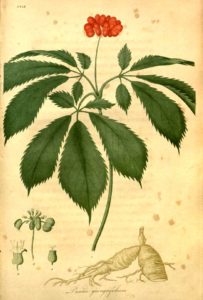 American Ginseng image found on wikipedia.org.
American Ginseng image found on wikipedia.org.
“Ginseng” is probably the best known adaptogen in the marketplace, yet there are many non-ginseng herbs. The chemistry of adaptogens is unusual and unique among plants. Ginseng’s major component is ginsenosides. Components of others illustrated below are unique: Cordyceps is cordyseptic acid, Schisandra’s is shisandrins, Holy Basil’s is ursolic acid.
So, how does an herb qualify as an adaptogen?
An herb classified as an adaptogen has three basic qualities: it’s non-toxic, produces a non-specific state of resistance to stress, and has a normalizing influence on the body. –p.21
How do adaptogens use our hormones?
Adaptogens have chemistry that acts to strengthen the body’s own energy reserves. During stress, certain hormones like cortisol, adrenaline, thyroid-stimulating hormones and others get released. Too much hormonal activity prevents the immune system from doing its job. Enter adaptogens. These herbs have an affinity for the nervous, endocrine and immune systems of the body.
More than a handbook for natural medicine practitioners, even budding herbalists.
Offering technical information as well as anecdote, David Winston’s Adaptogens is an herbal manual containing the key points about selected herbs, synergy with other herbs, and their actions in the human body.
Besides an herbal profile or monograph containing plant identity, energetics, plant history, and modern uses, selected herbal studies are listed with their results. Safety information in addition to the plant’s safety rating (number of stars), dosage indications and selected research studies complete each monograph.
The value of these plants is addressed in detail together with your body’s requirements for support under the seven chronic stressors. You could have stress from bacteria, exposure to toxins, extreme temperatures, dampness or dryness, food allergies, high blood pressure, depression and anxiety, etc., or feeling lost in life. –p 77. Winston focuses on the stress response, the actions and health benefits of taking adaptogens, even how to combine them effectively.
Winston describes Ginseng in China and Holy Basil in India as among the oldest known adaptogenic herbs. Depicted in materia medica of these ancient systems, what we now call adaptogens have always been a special class of herbs. They are prized for healing and yet they don’t eliminate or get rid of diseases. Instead they strengthen the body that can heal itself.
Schisandra, Holy Basil and Cordyceps represent just 3 of the adaptogens. All are herbs—a vine, a potherb and a wild-mountainside or meadow fungus. 22 more for a total of 25 adaptogens are detailed in the manual Adaptogens Herbs for Strength, Stamina and Stress Relief.
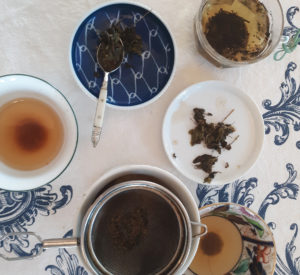 |
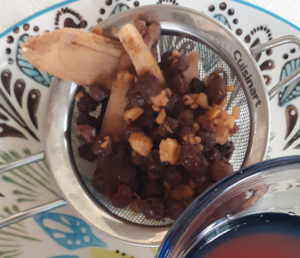 |
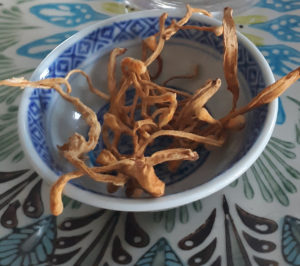 |
Herbs Schisandra, Holy Basil and Cordyceps, used for centuries in Asia. These are herbs that we now know act on the HPA axis or the hypothalamic-pituitary-adrenal axis, a system that activates and regulates the stress response in humans.
From the modern perspective
Winston reports that scientists in the mid-twentieth century wanted to develop an adaptation response for athletes. This response would reverse the usual overwhelm caused by excessive stress. Russian scientists observed that by taking herbs prior to experiencing stress, physical endurance was enhanced and the effects of exhaustion were controlled. Herbs such as eleuthero ginseng effectively increased athletic performance because they strengthen the adaptation response.
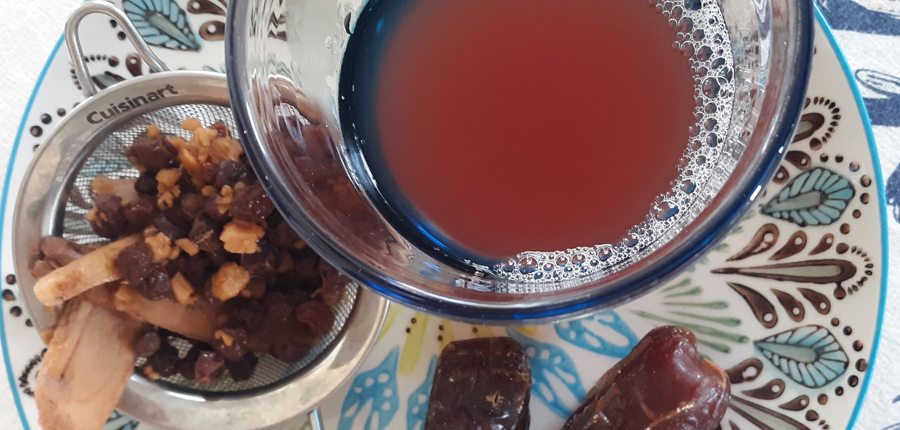
What is the adaptation response?
The adaptation response is the body’s way to normalize, or regain homeostasis during stress. Of these herbal properties, Winston says:
“Adaptogens… help the body adapt to stress, support normal metabolic processes, and restore balance.” –Introduction.
Adaptogens, by David Winston and Steven Maimes, consists of three parts.
Part One: Herbal Adaptogens, describes the usefulness, actions and benefits of adaptogenic herbs. Part Two: Materia Medica consists of mongraphs on 25 herbs, 12 nervines and 9 nootropics. In the last section of the Materia Medica Winston discusses Restorative Tonics, 9 herbs that complement adaptogens or offer superior nutrition.
Part Three: Herbal Adaptogens in Use paints a broad brush of application: the adaptogenic herbs in formulas, as food and in clinical application, and finally, for animals.
Case studies call the shots
In Winston’s Adaptogens, fourteen recent case studies by herbalists will give you an idea of the reasons why adaptogens, rather than pharmaceuticals, were chosen to help people in distress. Once you read how carefully each case is reviewed, you might feel some confidence that adaptogens could work for you.
For chronic stress, an herbalist/practitioner will create a customized formula best suited to your type of stress, and include herbs not classified as adaptogens. These herbs act on your nerves and are called nervines, and on your brain and are called nootropics. Additionally, there are herbs called restoratives that have a more general application.
Ancient traditional herbalists in Chinese and Ayurvedic systems always used formulas, and so does Winston. Formulas allow the herbalist to use assistant or complementary herbs. Nervines, nootropics and adaptogens–herbs for the brain, restorative herbs, and the main adaptogen–all together in one tidy package, become the therapeutic formula.
Modern herbalists have used the medicinal properties in adaptogens for a few hundred years, while ancient medicinal systems in Asia, Ayurveda and Chinese Herbal Medicine have known about and experienced the value of these herbs for millennia. That’s right—thousands of years! As author Winston points out, there are many published studies on adaptogens as we know them. And, he says, thousands of years of evidence that these herbs are amphoteric—meaning that they normalize an organ in the body—only underscores the importance that modern science gives them.
The plants themselves are a testament to endurance. Yet because they’re so powerful and can enact change in your body, you need guidance from an herbalist. Before taking these herbs in therapeutic doses, please consult an herbalist or functional medicine doctor.
Could you be a candidate for adaptogen use? As a handbook, Adaptogens Herbs for Strength, Stamina and Stress Relief can help you understand or communicate with a natural medicine practitioner or herbalist. It can answer some of your questions about taking herbs to mitigate stress. Further, Adaptogens can be your go-to manual for adaptogenic herbs as you study herbalism or for the herbalists’ registration exam. As a client or professional, all paths will be enriched with this manual, now in its second edition. See my review of the first edition, here.
Visit David Winston’s website for more background on herbs.



